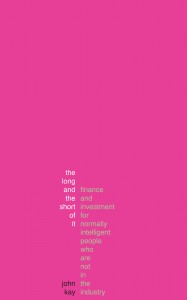 John Kay is a leading British economist and columnist for the Financial Times. His latest book is entitled The Long and the Short of it: A Guide to Finance and Investment for Normally Intelligent People Who Aren’t in the Industry.
John Kay is a leading British economist and columnist for the Financial Times. His latest book is entitled The Long and the Short of it: A Guide to Finance and Investment for Normally Intelligent People Who Aren’t in the Industry.
Jonathan Mok: What was the impetus behind this book?
John Kay: Many friends over the years have asked me – ‘what can I read that tells me about finance and investment in a non-technical way but doesn’t insult my intelligence?’ Few books do this. I have often recommended Burton Malkiel’s A Random Walk down Wall Street, but that book is now old (first published in the 1970s) and very American. So I thought I would have a go myself. And the credit crunch made it all the more topical.
Jonathan: In your book, you urge readers to take care of their investment portfolio and provided tremendous advice and figures on how to spot and assess an investment option. Tell me, why did most investment models, built by Harvard, Yale and Cambridge Mathematics PhDs, appear to fail?
John: Put simply, people made the mistake of believing the model. The people who built them – the mathematics PhDs – didn’t know very much about the world. The people who knew about the world didn’t understand the mathematics. Both groups had inappropriate confidence in the value of these models. They aren’t useless – but models can only illuminate the world, never be a substitute for judgment. That is one of the central messages of the book.
Jonathan: What are the differences in risks and opportunities an investor faced before and after the “financial tsunami” in 2008?
John: Two years ago, there weren’t many cheap assets around. Now there are a lot. But the basic principles of investment haven’t changed. And the messages I put forward – pay less, diversify, be contrarian – were true then and are true now.
Jonathan: After incidents such as the collapse of Lehman Brothers and the heavy government injection into the capital of banks such as Royal Bank of Scotland, what are the real prospects for the investment industry?
John: I hope banks will go back to being boring banks – that take deposits and make loans and offer mortgages, and not kid themselves they can make easy money in speculative trading on their own account. I don’t expect they will, however – even the nationalized ones.
Jonathan: Finally, I just have to ask, did having long walks in the mountains behind the French Riviera really help shape your writing of the book?
John: For years, I have identified what I think of as ‘long walk’ problems – knotty issues that are best tackled if you can get away from it all. I often come back with an answer, or a few paragraphs, composed in my head.

The Long and Short of It: A Review. The Erasmus Press. 2009.
2008 was the year of financial Armageddon. The collapse of Lehman Brothers, the government bailouts, etc., all reminded us that investment and commercial banks were not able to provide financial salvation for millions of common men and women trying to create a solid foundation for retirement. The exposure of Bernard Madoff’s Ponzi scheme taught us that investment bankers and hedge fund managers were not prophets, but fallible human beings.
In his latest book, John Kay, a columnist for the Financial Times, has written the investment gospel for, to use his language, “normally intelligent investors.” The most important message from the book is “ your money is your blood”.
With his blunt style, Kay does an excellent job exposing the ugly side of the world inhabited by investment bankers and financial planners. Kay is right to suggest that these people suddenly turn to socialism when their own businesses are in trouble. The so-called investment models, developed by academics and stock analysts, as in case of Long-Term Capital Management in 1998, are deceptive, Kay argues, since they don’t not consider the mood of the market and the impacts of external events.
Kay does an equally fantastic job asking us to notice and dissect the messages and slogans used in the market. For example, the often-heard corporation’s statement “ Maximizing profits for shareholders” should be interpreted as “Maximizing profits for the president” – since the president is the biggest holder of the company, and don’t you forget it. Decoding the language of the market is crucial for the average investor.
Kay’s recommendations when it comes to investment strategies—pay less, diversify more and be contrarian – may at first seem like they’re insulting your intelligence, but they are especially needed today, as the markets continue to confuse and frustrate millions of investors.
Investment is usually supposed to be a boring, dense subject – which is part of the reason why so few people adequately educated as to its rules. The use of humor – such as linking technical analysts of stocks to astrologists – makes this book especially enjoyable to read. Yet, even as he is making us laugh, Kay is appealing to old values: No pain, no gain, and please do your homework, unless you want to get burned.
My only regret is that in this volume, Kay did not get to a deeper explanation regarding the American economic bubbles. The history of these bubbles may make you wonder if it has anything to do with having Republicans in the White House, but a deeper analysis is needed.
Kay’s book does not teach anything new, and that is precisely its beauty. We need to go back to time-honored advice now. Kay relies on traditional teachings: being knowledgeable of your investment, being realistic about the rate of return, understanding your financial goal and putting eggs into different baskets. In the present climate of uncertainty, Kay’s wisdom is a guiding light for both veteran and beginner investors.
